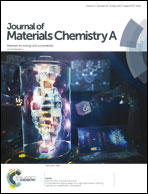Ni–Pd core–shell nanoparticles with Pt-like oxygen reduction electrocatalytic performance in both acidic and alkaline electrolytes†
Abstract
Fabrication of non-Pt high-performance oxygen reduction reaction (ORR) catalysts is essential for the application of fuel cells. In this work, monodisperse bimetallic Ni–Pd core–shell nanoparticles (NPs) with tunable shell compositions and contents were synthesized by using a modified one-pot colloidal approach and characterized. Also, the core shell structure dependence of their ORR performance without the interruption of an intermetallic phase was explored. The core–shell structured catalysts (Ni@Pd3/C NPs) exhibited a robust ORR activity and stability with a high onset potential of 0.99 V, a half-wave potential of 0.87 V and an average electron transfer number of 3.91 in 0.1 M HClO4. Furthermore, a high onset potential of 0.98 V, a half-wave potential of 0.86 V and an average electron transfer number of 3.98 were achieved in 0.1 M KOH. These results are comparable to those of the commercially available Pt/C catalysts. Moreover, the catalysts also maintained a good long-term cycling stability in both acidic and alkaline electrolytes. Thus, this work demonstrates that the ORR performance of the Ni–Pd alloy could be boosted through constructing the core–shell structure with a Pd-enriched surface and the Ni–Pd model alloy could be further applied to assess the role of the Pd-based core–shell structure in other electrochemical catalytic reactions.



 Please wait while we load your content...
Please wait while we load your content...